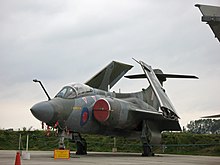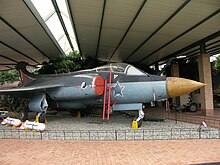Blackburn Buccaneer
The Blackburn Buccaneer was a British low level strike aircraft serving with the Royal Navy and the Royal Air Force. Designed and initially produced by Blackburn Aircraft it was later known as the Hawker Siddeley Buccaneer when Blackburn became a part of the Hawker Siddeley group.
Design and development
In the early 1950s the Russian Navy introduced the Sverdlov class cruiser into service. Light cruisers by World War II measure, they were nevertheless fast, effectively armed, and numerous. They presented a serious threat to the merchant fleets in the Atlantic, similar to the German pocket battleships of the war, but in far greater numbers and over 25% faster. To counter this threat the Royal Navy decided to counter the Sverdlovs not with a new ship class of their own, but a new specialised strike aircraft employing conventional or nuclear weapons. Operating from their fleet carriers and attacking at high-speed and low-level, they would offer a solution to the Sverdlov problem.
A detailed specification was issued in June 1952 as Naval Staff Requirement NA39, calling for a two-seat aircraft with folding wings, capable of flying at Mach 0.85 at 200 ft, having a combat range of over 400 nm, and carrying a nuclear weapon internally. Based on the requirement, in August 1952 the Ministry of Supply issued specification M.148T, and the first responses were returned in February 1953.[1]
Blackburn's design by B. P. Laight, Project B-103, won the tender. Due to secrecy, the aircraft was called BNA (Blackburn Naval Aircraft) or BANA (Blackburn Advanced Naval Aircraft) in documents leading to the obvious nickname of "Banana Jet". (Other sources have described the initial project title as 'ARNA,' 'A Royal Navy Aircraft,' with Blackburn ARNA quickly becoming 'Banana'.)
The Buccaneer was a mid-winged, twin-engined monoplane with a crew of two seated in tandem under a sliding canopy. To meet the demands of the specification the Buccaneer featured a number of advanced design features. The fuselage was area ruled; meaning it was designed to reduce drag at transonic speeds. This gives rise to the characteristic curvy "Coke bottle" shape. It featured a variable incidence tailplane that could be trimmed to suit the particular requirements of low-speed handling or high-speed flight. At the low-levels and high speeds traditional bomb bay doors could not be opened safely into the air stream, therefore doors were developed that rotated into the fuselage to expose the payload. This was also useful in assisting ground-level access.



The small wing of the Buccaneer was suited to high-speed flight at low level. Such a wing, however, did not generate the lift that was essential for low-speed carrier operations. Therefore, the wing and horizontal stabiliser were "blown" by bleeding compressor gas from the engine through surface vents. A consequence of the blown wing was that the engines were required to run at high power for low-speed flight in order to generate sufficient compressor gas for blowing. Blackburn's solution to this situation was to provide a large air brake. The tail cone was formed from two leaves that could be hydraulically opened into the airstream to decelerate the aircraft. The nose cone and radar antennae could also be swung around by 180 degrees to reduce the length of the aircraft in the carrier hangar. This feature was particularly important as contemporary British aircraft carriers were small.
The first Buccaneer model, the S.1, was powered by a pair of de Havilland Gyron Junior turbojets producing 7,100 pounds of thrust. [2] This mark was somewhat underpowered, and as a consequence could not take off fully laden with both fuel and armament. A temporary solution to this problem was the "buddy" system; aircraft took off with a full load of weaponry and minimal fuel and would sortie with a Supermarine Scimitar that would deliver the full load of fuel by aerial refuelling. This was not an ideal solution however, as the loss of an engine during take-off could have been catastrophic, and the Gyron Junior gave a poor range due to high fuel consumption. The long term solution was the S.2, fitted with the Rolls-Royce Spey turbofan, providing 40% more thrust with a greatly reduced fuel consumption. The engine nacelles had to be enlarged to accommodate the Spey, and the wing required minor aerodynamic modifications as a result. The S.2 Buccaneer had completely replaced the S.1 by November 1966.
With the introduction of the Martel air-to-surface missile, some Mark 2 aircraft were converted to carry it, and became S.2D. The remaining aircraft became S.2C. Sixteen aircraft were built (and fifteen delivered) for the South African Air Force as the S.50, S.2 aircraft with the addition of Bristol Siddeley BS.605 rocket engines to provide additional thrust for the "hot and high" African airfields.
When the Fleet Air Arm's fixed-wing operations ended in 1978, 62 of the 84 Buccaneer Mark 2 aircraft were transferred to the Royal Air Force (RAF) as S.2A. These joined 26 aircraft that had been built by Blackburn's successor, Hawker Siddeley for the RAF as the S.2B. These aircraft were not navalised and, like the S.2A, had RAF-type communications and avionics equipment.
Modifications
British aircraft were given upgrades. Self-defence was improved by the addition of the AN/ALQ-101 ECM pod, chaff and flare dispensers and the Sidewinder missile. RAF low-level strike Buccaneers carried what was known as "retard defence"; four 1,000 pound retarded bombs internally that could be dropped to provide an effective deterrent against any following aircraft. They were able to operate the AN/AVQ 23E Pave Spike laser designator pod for Paveway II guided bombs and act as target designators for other aircraft. From 1986 No. 208 Squadron RAF used them with the Sea Eagle anti-ship missile.
There were no dual control trainer versions of the Buccaneer constructed. As a consequence, the Buccaneer OCU utilised Hunter T7s with modified controls to simulate the cockpit of the buccaneer for conversion training.
Operational history
The Buccaneer entered service in 1962. In addition to conventional ordnance, in 1965 the Buccaneer was type-approved for nuclear weapons delivery i.e. the Red Beard and WE177 bombs. All nuclear weapons were carried internally. It left Fleet Air Arm service with the decommissioning of HMS Ark Royal in 1978, with the remaining examples being transferred to the RAF.
The first RAF formation to receive the Buccaneer S2 was 12 Squadron at RAF Honington in 1969. This was to remain a key station for the type as 15 Squadron equipped with the Buccaneer the following year. Retired FAA aircraft subsequently equipped 16 Squadron and 208 Squadron. The last FAA aircraft went to 216 Squadron. In 1980, the Buccaneer squadrons moved to RAF Lossiemouth. The Buccaneer saw war service during the 1991 Gulf War when examples were rushed to the area to provide a laser designation capability for British aircraft, and dropping small numbers of laser-guided bombs themselves. The last Buccaneers were withdrawn in March 1994 when 208 Squadron disbanded. [3]
South Africa was the only country other than the UK to operate the Buccaneer, where it was in service with the South African Air Force from 1965 to 1991.
Variants

- Buccaneer
- Preproduction build of 20 aircraft.
- Buccaneer S.1
- First production model, powered by the Gyron Junior turbojet engines. 40 built.
- Buccaneer S.2
- Conversion of the S.1 with various improvements and powered by the more powerful Rolls-Royce Spey turbofan engines. From 1962 10 were converted by Blackburn Aircraft Ltd. and 74 by Hawker Siddeley Aviation Ltd.
- Buccaneer S.2A
- Ex-Royal Navy aircraft reworked for RAF.
- Buccaneer S.2B
- Variant for RAF squadrons. Fully equipped and could carry the Martel anti-radar or anti-shipping missile. 45 built between 1973 and 1977.
- Buccaneer S.2C
- Royal Navy aircraft upgraded to S.2A standard.
- Buccaneer S.2D
- Royal Navy aircraft upgraded to S.2B standard, operational with Martels from 1975.
- Buccaneer S.50
- Variant for South Africa. Wings could be folded but folding was no longer powered. Aircraft could be equipped with two single-stage rockets (see RATO) to assist take-off from hot-and-high airfields like that of AFB Waterkloof in Pretoria, where the type was mostly based.
Operators

- Royal Air Force
- No. 12 Squadron RAF
- No. XV Squadron RAF
- No. 16 Squadron RAF
- No. 208 Squadron RAF
- No. 216 Squadron RAF
- No. 237 Operational Conversion Unit, RAF
- Fleet Air Arm
- 700Z Naval Air Squadron (Intensive Flying Trials Unit)
- 700B Naval Air Squadron
- 736 Naval Air Squadron
- 800 Naval Air Squadron
- 801 Naval Air Squadron
- 803 Naval Air Squadron
- 809 Naval Air Squadron
Survivors
- Three Buccaneers are still airworthy in 2008, all three are privately owned and located at Thunder City in Cape Town. These aircraft can be rented for private flights.[4]
- In the UK a Buccaneer (S.2, XX885) is being rebuilt to flying condition by Hawker Hunter Aviation, it was granted UK CAA permission to fly in April 2006. [5]
- A number of Buccaneers in the UK are in fast taxiing condition and several more are being rebuilt to taxing condition.[6] [7]
Specifications (Buccaneer S.2)

Data from The Observer's Book of Aircraft[8]
General characteristics
- Crew: 2
Performance
- Thrust/weight: 0.36
Armament
- Up to 12,000 lb (5,400 kg) of ordnance carried in the internal bomb bay and on four underwing hardpoints
See also
Aircraft of comparable role, configuration, and era
Related lists
References
Notes
- ^ Blackburn Buccaneer, spyflight
- ^ Green, 1964. p. 430.
- ^ = Jefford
- ^ ThunderCity Buccaneer page
- ^ Blackburn Buccaneer.co.uk, XX885 page
- ^ XX894
- ^ XW544
- ^ Green, 1968. p. 136.
Bibliography
- Green, William. Aircraft Handbook. London. Macdonald & Co. (Publishers) Ltd., 1964.
- Green, William. The Observer's Book of Aircraft. London. Frederick Warne & Co. Ltd., 1968.
- Jefford, C.G., RAF Squadrons. Shrewsbury: Airlife Publishing, 2nd edition, 2001. ISBN 1-84037-141-2
External links
- The Blackburn Buccaneer Society
- Blackburn Buccaneer: The Last British bomber
- Blackburn Buccaneer from Thunder and Lightnings
- The Blackburn Buccaneer at Air Vectors
- Buccaneer gallery
- Blackburn Buccaneer: The awesome 'Banana' Jet
- The FAA Buccaneer Association
- Animated nuclear weapon drop sequence from a Buccaneer S2.
- Nuclear weapon drop methods including from a Buccaneer.
